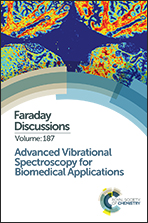Towards quantitative molecular mapping of cells by Raman microscopy: using AFM for decoupling molecular concentration and cell topography†
Abstract
Raman micro-spectroscopy (RMS) is a non-invasive technique for imaging live cells in vitro. However, obtaining quantitative molecular information from Raman spectra is difficult because the intensity of a Raman band is proportional to the number of molecules in the sampled volume, which depends on the local molecular concentration and the thickness of the cell. In order to understand these effects, we combined RMS with atomic force microscopy (AFM), a technique that can measure accurately the thickness profile of the cells. Solution-based calibration models for RNA and albumin were developed to create quantitative maps of RNA and proteins in individual fixed cells. The maps were built by applying the solution-based calibration models, based on partial least squares fitting (PLS), on raster-scan Raman maps, after accounting for the local cell height obtained from the AFM. We found that concentrations of RNA in the cytoplasm of mouse neuroprogenitor stem cells (NSCs) were as high as 25 ± 6 mg ml−1, while proteins were distributed more uniformly and reached concentrations as high as ∼50 ± 12 mg ml−1. The combined AFM–Raman datasets from fixed cells were also used to investigate potential improvements for normalization of Raman spectral maps. For all Raman maps of fixed cells (n = 10), we found a linear relationship between the scores corresponding to the first component (PC1) and the cell height profile obtained by AFM. We used PC1 scores to reconstruct the relative height profiles of independent cells (n = 10), and obtained correlation coefficients with AFM maps higher than 0.99. Using this normalization method, qualitative maps of RNA and protein were used to obtain concentrations for live NSCs. While this study demonstrates the potential of using AFM and RMS for measuring concentration maps for individual NSCs in vitro, further studies are required to establish the robustness of the normalization method based on principal component analysis when comparing Raman spectra of cells with large morphological differences.
- This article is part of the themed collection: Advanced Vibrational Spectroscopy for Biomedical Applications

 Please wait while we load your content...
Please wait while we load your content...